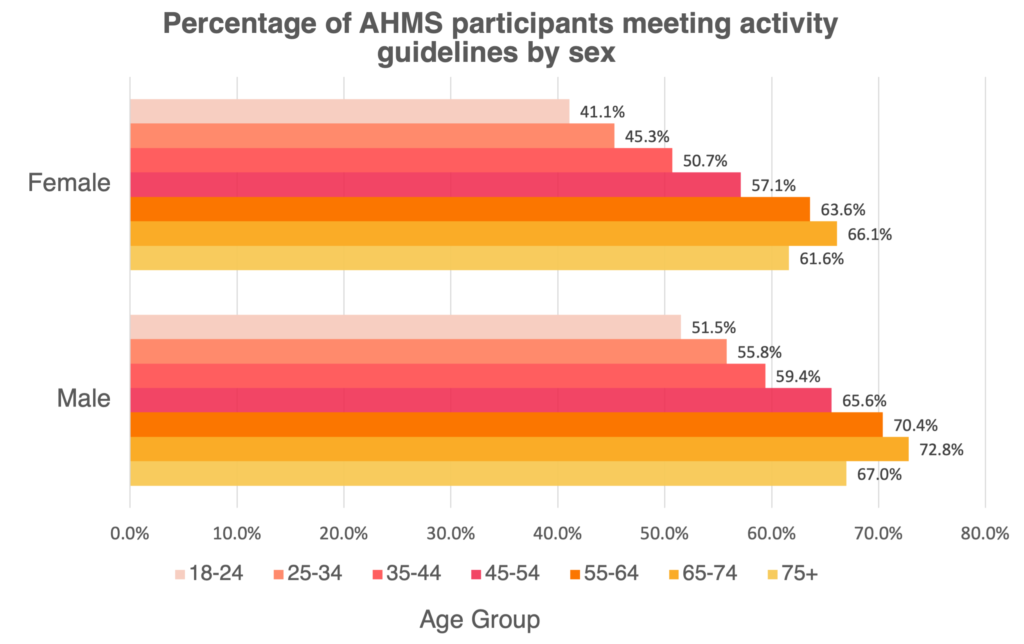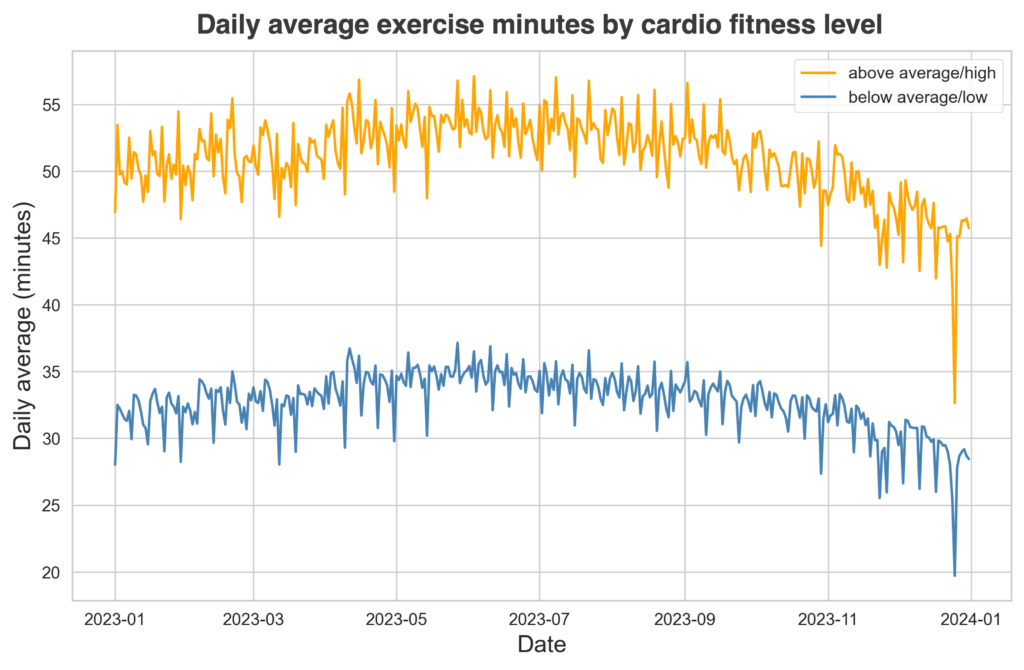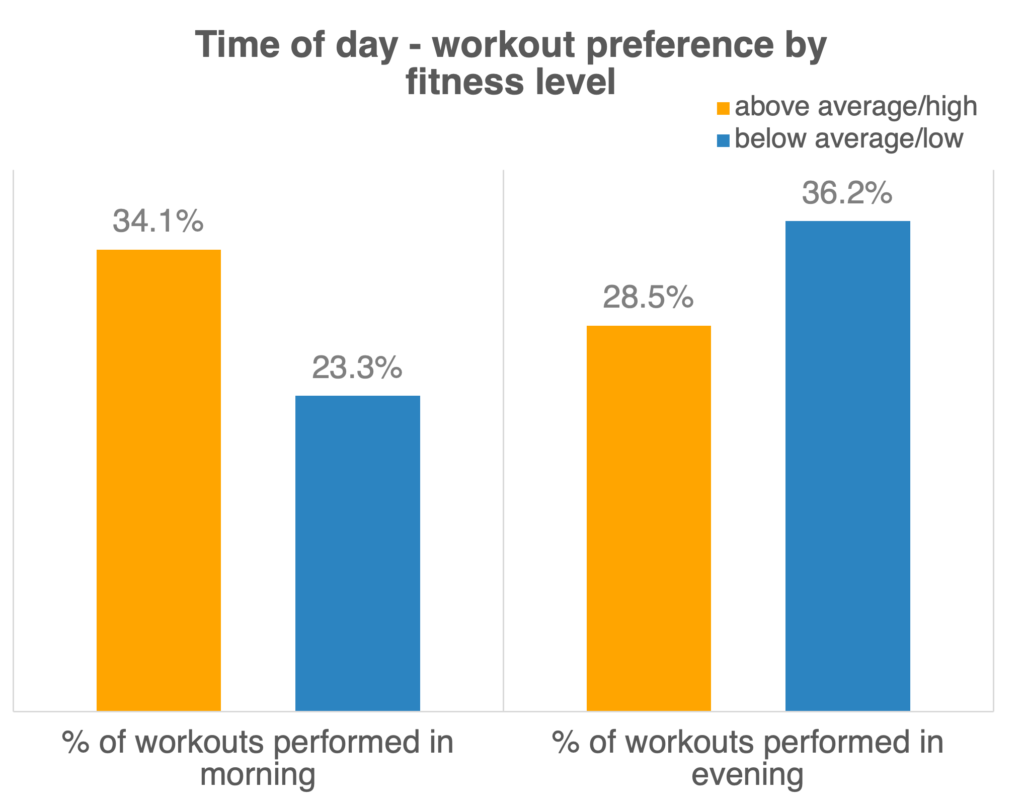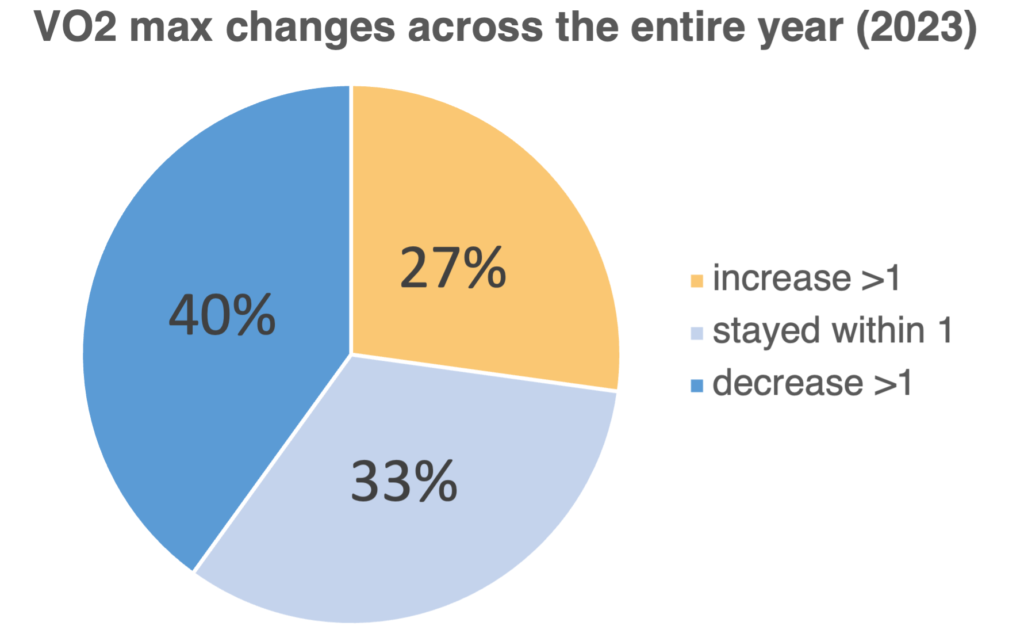
Life’s Essential 8 – How to be More Active
Life’s Essential 8, a framework established by the American Heart Association (AHA), is a more holistic approach to defining a ‘score’ for cardiovascular health that incorporates health behaviors and other factors associated with improvements in longevity, cardiovascular disease-free survival, and quality of life.1 The AHA guidelines include getting at least 150 minutes per week of moderate aerobic activity or, 75 minutes per week of vigorous aerobic activity, or a combination of both, and muscle-strengthening activities at least two days per week. We use these guidelines to evaluate activity as part of this Heart Month Update.
Activity in Apple Heart and Movement Study Participants
Determining what constitutes “moderate” or “vigorous” activity is challenging for individuals and researchers. Focusing on moderate, this has been defined as an activity that:
-
- Causes a small increase in breathing or heart rate2 (PAQ-K)
- Allows you to talk but not sing while active3 (Talk Test)
- Is associated with a heart rate between 64 – 76% of maximal heart rate4 (CDC)
- Results in a perceived exertion rating of 12 to 14 on a scale of 6 to 205 (Borg Scale)
To assess the average activity duration in Study participants, we used the Apple Watch Activity app metric Exercise Minutes, represented as the green ring. Exercise minutes accumulate throughout the day when Apple Watch is worn and include both passively captured brisk activity minutes detected by watch and participant-logged activity data collected using Workout app or third-party apps. All individuals with at least six weeks of activity days over the 12-months were analyzed for a total of 92,793 participants. Details on the criteria and characteristics of the cohort selection can be found in Table 1.

Figure 1: This bar chart demonstrates, by assigned sex, the percentage of participants (N=92,793) in each age group who, on average, meet the 150-minute recommendation for moderate aerobic activity in 2023. The data presented in this chart is viewable in Table 2.
An impressive 54.8% (N=>53,562) of participants averaged 150 minutes or more of moderate activity per week, with the percentage increasing with age and higher for males. According to data from the National Center for Health Statistics, National Health Interview Survey, 2020, 46.3% of Americans met the aerobic guidelines, putting AHMS participants ahead in aerobic activity, especially in the older population.6
To look at differences among states across the US, the map below shows the proportion of participants within each state who met the 150-minute aerobic activity requirement, adjusted for age.

Figure 2: Percentage of participants who average at least 150 minutes a week by state, adjusted for age. Massachusetts had the highest proportion, with 67.2%, and Mississippi ranked lowest, with 38.5%. The data presented in this figure is viewable in Table 4, including details by state, district, and territory.
Massachusetts (67.2%), New York (66.0%), and Connecticut (64.1%) were the top three states with the highest proportion of participants meeting the aerobic guideline, with Oklahoma (41.4%), Louisiana (41.3%), and Mississippi (38.5%) ranking at the bottom. Many factors can contribute to these differences, including the distribution of participants in each state living in more rural or metropolitan areas, income levels, and outdoor access, among others.
Adding Strength
Among participants who averaged at least 150 minutes of activity per week, we were interested to see how many also logged, on average, at least two muscle-strengthening activities per week. According to guidelines, strength workouts should include all major body muscle groups —legs, hips, back, chest, abdomen, shoulders, and arms. Analyzing workouts labeled as functional strength training, traditional strength training, Pilates, and barre, the results were notable across all age groups. Only 8.9% (N=8,221) of the studied cohort met both aerobic and strengthening guidelines. An additional 6.5% (N=6,019) met the minimum 150 minutes of moderate aerobic activity and an average of one strength workout weekly.

Figure 3: This bar chart demonstrates, by recommendation, the percentage of participants (N=92,793) in each age group who, on average, meet the 150-minute recommendation for aerobic activity vs those who also have an average weekly count of two strength workouts in 2023. The data presented in this chart is viewable in Table 5.
Interestingly, as seen in Figure 3, younger participants were more likely to achieve an average weekly goal of two strength workouts per week, resulting in a flip of the trend based on age groups meeting recommendations. It’s important to note that individuals must proactively log strength training workouts, which may lead to underestimating strength training activities relative to passively tracked activity minutes.
How Do Cardio Fitness and Activity Levels Compare?
Although cardio fitness, or VO2 max, is not included in AHA’s guidelines, measuring cardio fitness is gaining traction in the health and wellness space. This is largely due to wearable devices like Apple Watch being able to estimate an individual’s fitness levels without needing a formal exercise test in a lab setting. Higher cardio fitness levels are associated with reductions in all-cause relative mortality risk across all age, sex, and race classifiers.7 To that end, we looked at individuals with at least 10 VO2 max values across 2023 (N=73,309), taking the average for each participant and categorizing individuals using cardio fitness levels derived from the Fitness Registry and Importance of Exercise National Database (FRIEND), including consideration of age and sex.8 Looking at the entire year’s data, the average number of exercise minutes measured for those with yearly average VO2 max scores that were low or below average classification, and those with an above average or high classification, are plotted in Figure 4.

Figure 4: The mean exercise minutes logged by day grouped by participants with above average/high (N = 22,740) and below average/low (N=50,569) cardio fitness levels based on at least ten VO2 max samples across 2023 (Total N=73,309). The demographic characteristics of both groups in this chart are viewable in Table 6.
On average, those with higher cardio fitness levels tend to exercise over 15 minutes longer per day than those with lower levels. Interestingly, while there was a large difference in the amount of exercise, there was no difference in popularity for days of the week on which to be most (or least) active. Both groups were most active on Saturdays, then Tuesday, Monday, Wednesday, Thursday, Friday, and lastly Sunday. Additionally, for all, on average, the least active day was December 25th, Christmas Day, and the most active day was May 27th (the Saturday of Memorial Day weekend).
Do individuals with higher cardio fitness levels workout at different times of day compared to lower levels?
To answer this question, we analyzed the percentage of workouts recorded at any given hour of the day in participants, comparing the higher and lower cardio fitness groups. The figure below shows the distribution of when workouts were started for both groups. When looking at the raw count of all exercises recorded, there is a bimodal distribution of workouts in the morning and evening.

Figure 5: Across all workouts collected in 2023 for the 73,309 meeting criteria, this bar graph shows the percentage of workouts started in each hour of the day (local time) for all participants grouped by cardio fitness level. The data presented in this chart is viewable in Table 7.
To limit the possible skewing of data due to considerable variability in the number of workouts for each participant, we then calculated each individual’s proportion of workout start times logged in the morning (4:00 am – 10:59 am), mid-day (11:00 am – 3:59 pm), evening (4:00 pm – 9:59 pm) and late night (10:00 pm – 3:59 am). Taking the average across the higher and lower groups, we found participants with higher cardio fitness logged a higher percentage of workouts during the morning hours, an average of 34.1% of workouts for higher vs 23.3% for lower. Conversely, participants with lower cardio fitness levels tended to log more activity in the evening, 28.5% for higher vs 36.2% for lower.

Figure 6: The average percentage of workouts that begin in the morning vs evening for participants grouped by above average/high and below average/low cardio fitness levels. Not visualized: 35.6% of workouts began mid-day and 1.8% of workouts began in late-night hours in the above average/high group, 37.1% of workouts began mid-day and 3.4% of workouts began in late-night hours in the below average/low group. The data presented in this chart is viewable in Table 8.
This difference was an interesting finding and may relate to a participant’s ability to achieve more activity throughout the day by starting early, which may positively affect cardio fitness levels. However, other potential reasons for this pattern include where and why people exercise. Fortunately, there are ways to address such questions with adaptive real-world studies like the Apple Heart and Movement Study.
Who was able to improve their Cardio Fitness over the year?
Since small improvements in cardio fitness can reduce overall cardiovascular risk, we looked at who maintained or increased their VO2 max over the year. To do this, for participants who had at least two VO2 max values in the first and last two months of the year (N=47,840), we took the difference between the average VO2 max values in these months, 27% of participants increased their Cardio Fitness by more than 1 mL/kg/min and 33% remained within 1 mL/kg/min.

Figure 7: Based on the average of the first two and last two months of the year, this pie chart demonstrates that of the 47,840 participants analyzed, 27% (N = 12,781) increased their VO2 max by more than 1 mL/kg/min, 33% (N = 15,760) stayed within 1 mL/kg/min, and 40% (N = 19,299) decreased by more than 1 mL/kg/min. The data presented in this chart is viewable in Table 9.
When applying a basic logistic regression, participants were more likely to improve their cardio fitness by more than 1 mL/kg/min if they were male, at a lower fitness level to start, and in the less than 30-year-old group. Cardio fitness naturally declines as age increases, but physical activity can help combat that decline. How much an individual’s values change with regimented physical activity has had varying results in past controlled studies. Our research team continues to explore how to best model this variance in such a diverse, observational setting.9,10 Many questions remain, such as: Does the time of day of exercise matter? The fitness levels an individual achieved in youth years? The type of activity and peak heart rate? The variability in each person’s life makes the problem challenging but a great one to pursue.
As always, thank you to all of our AHMS participants for contributing your data and time to help pursue these challenging questions relating physical activity to its impact on heart health and beyond.
Here are a few useful resources for using Apple Watch to track activity and cardio fitness levels:
Use the Activity app on your Apple Watch
This study update was revised on February 29th with new references to supplemental data found here and a correction to Figure 3 and its corresponding data.
Get the app. Join the Study.
- Lloyd-Jones DM, Allen NB, Anderson CAM, Black T, Brewer LC, Foraker RE, Grandner MA, Lavretsky H, Perak AM, Sharma G, Rosamond W; on behalf of the American Heart Association. Life’s essential 8: updating and enhancing the American Heart Association’s construct of cardiovascular health: a presidential advisory from the American Heart Association. Circulation. 2022;146:e18–e43. doi: 10.1161/CIR.0000000000001078
- NHANES 2019-2020 Physical Activity and Physical Fitness. Cdc.gov. Retrieved January 10, 2024, from https://wwwn.cdc.gov/nchs/data/nhanes/2019-2020/questionnaires/PAQ_K.pdf
-
Center for Disease Control. Measuring Physical Activity Intensity. Cdc.gov. Retrieved January 10, 2024, from https://www.cdc.gov/physicalactivity/basics/measuring/index.html
-
Center for Disease Control. Target Heart Rate and Estimated Maximum Heart Rate. Cdc.gov. Retrieved January 10, 2024, from https://www.cdc.gov/physicalactivity/basics/measuring/heartrate.htm
-
Center for Disease Control. Perceived Exertion (Borg Rating of Perceived Exertion Scale). Cdc.gov. Retrieved January 10, 2024, from https://www.cdc.gov/physicalactivity/basics/measuring/exertion.htm
- Elgaddal N, Kramarow EA, Reuben C. Physical activity among adults aged 18 and over: United States, 2020. NCHS Data Brief, no 443. Hyattsville, MD: National Center for Health Statistics. 2022. DOI: https://dx.doi.org/10.15620/cdc:120213
-
Kokkinos, P., Faselis, C., Samuel, I. B. H., Pittaras, A., Doumas, M., Murphy, R., … & Myers, J. (2022). Cardiorespiratory fitness and mortality risk across the spectra of age, race, and sex. Journal of the American College of Cardiology, 80(6), 598-609.
- Myers, J., Kaminsky, L. A., Lima, R., Christle, J. W., Ashley, E., & Arena, R. (2017). A reference equation for normal standards for VO2 max: analysis from the Fitness Registry and the Importance of Exercise National Database (FRIEND Registry). Progress in cardiovascular diseases, 60(1), 21-29.
- Bouchard, C., & Rankinen, T. (2001). Individual differences in response to regular physical activity. Medicine & Science in Sports & Exercise, 33(6), S446-S451.
- Väisänen, D., Ekblom, B., Wallin, P., Andersson, G., & Ekblom-Bak, E. (2024). Reference values for estimated VO2max by two submaximal cycle tests: the Åstrand-test and the Ekblom-Bak test. European Journal of Applied Physiology, 1-10.
Life’s Essential 8 name used with permission of the American Heart Association
